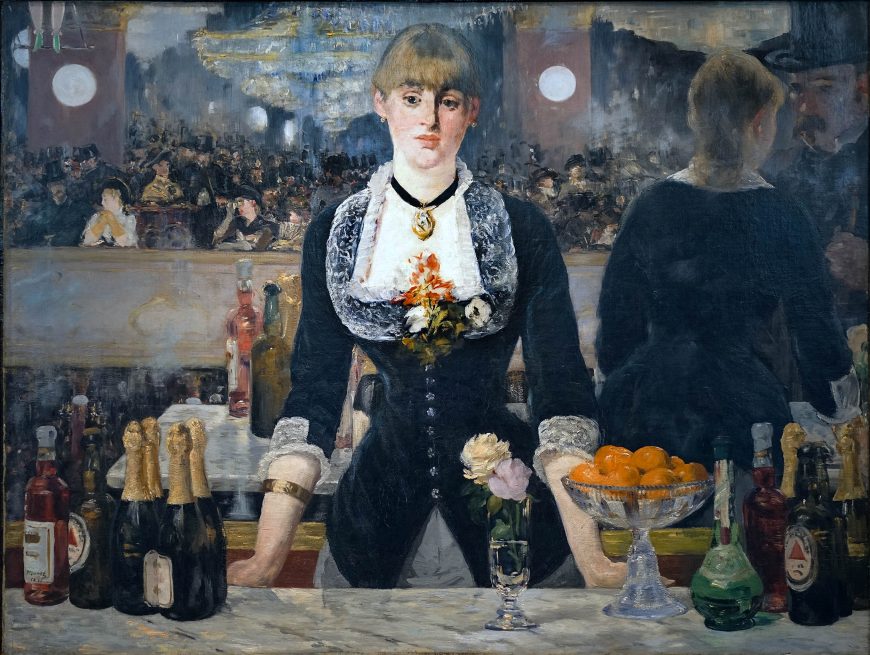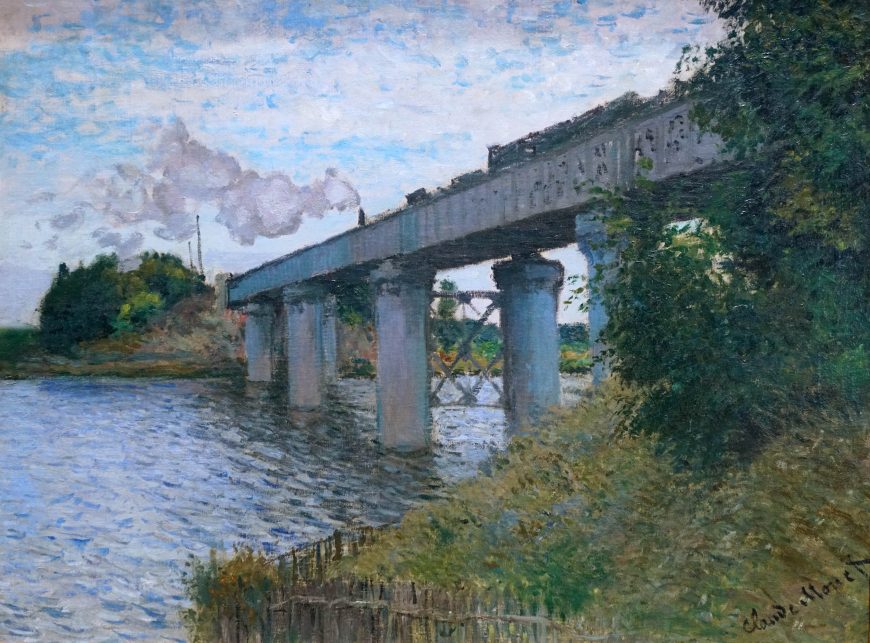
Claude Monet, The Railroad Bridge in Argenteuil (Le pont du chemin de fer à Argenteuil), 1873-74, oil on canvas, 54 x 71 cm (Musée d’Orsay, Paris)
Aggressively modern
This is one of many paintings by Monet of the railroad bridge leading to Argenteuil, a small town on the outskirts of Paris where the artist lived in the 1870s. The painting demonstrates the Impressionists’ well-known interest in depicting nature and the effects of weather and light, seen here in the expanse of white clouds in blue sky and the reflections in the rippling surface of the river. Highly textured dark green bushes and grass are built up with visible brushstrokes and anchor the painting’s composition on left and right. The subject of the painting, however, is not a timeless rural scene (these were popular with the public — see, for example, this painting by Corot), but an aggressively modern one of a railroad bridge with a train heading over the river.
The bridge was rebuilt at the beginning of the decade after its predecessor was destroyed in the Franco-Prussian war, and its parts were forged at the local ironworks. The steam engine racing across the bridge creates its own billowing gray steam clouds, competing with the natural ones. The sweeping perspective of the bridge suggests the speed and dynamism of modern transportation technology, but Monet also shows that technology as integrally connected to the natural world. The rickety wooden fence in the foreground creates a contrast between old construction materials and the massive concrete and iron pylons supporting the new bridge. Old and new strain to integrate in the modern landscape.
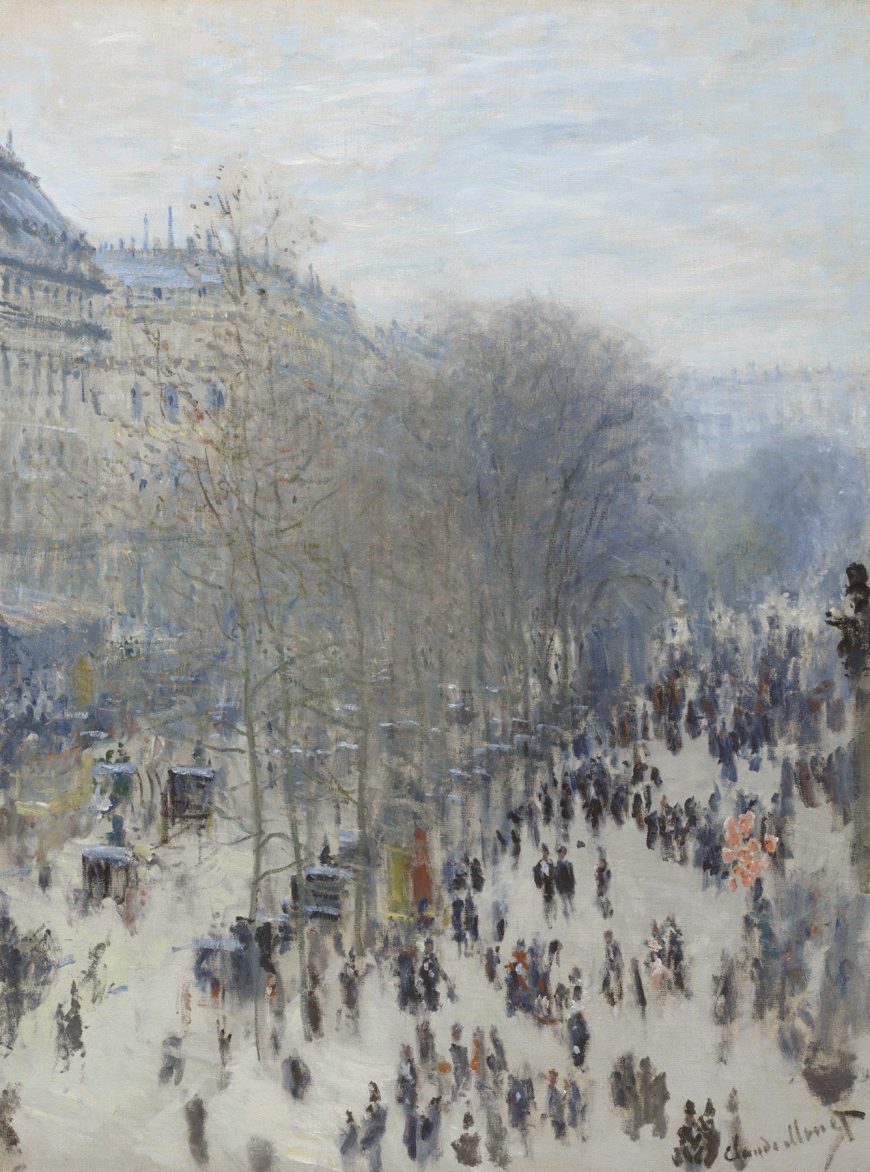
Claude Monet, Boulevard des Capucines, 1873-74, oil on canvas, 80.3 x 60.3 cm (Nelson-Atkins Museum of Art, Kansas City)
Subjects that matter
Until the last decades of the twentieth century the scholarship on Impressionism paid relatively little attention to the subject matter chosen by the artists. Before then, art historians mostly concentrated on the style of the works and the way Impressionist innovations in form heralded or consolidated what seemed to them to be the most significant feature of modern art: the liberation of the artist from the constraints of convention, and the “evolution” of art toward flatness and abstraction. In recent decades, however, art historians have seriously considered the subject matter represented in Impressionist paintings and how this subject matter would have been understood by contemporary viewers.
Painting modern life
The Impressionist style can, of course, be applied to any subject matter, but Impressionist artists concentrated on a surprisingly limited range of subjects: typically, middle-class leisure in modern urban or suburban environments such as the Paris boulevard depicted in Monet’s Boulevard des Capucines or Railroad Bridge at Argenteuil. In one sense, the Impressionists continued the tradition of earlier nineteenth-century Realists like Jean-François Millet (for example in his painting L’Angélus) in their insistence on painting scenes from contemporary life. They rejected historical, mythological, and other exotic subjects and took as their dictum, “Il faut être de son temps,” “one must be of one’s own time.”
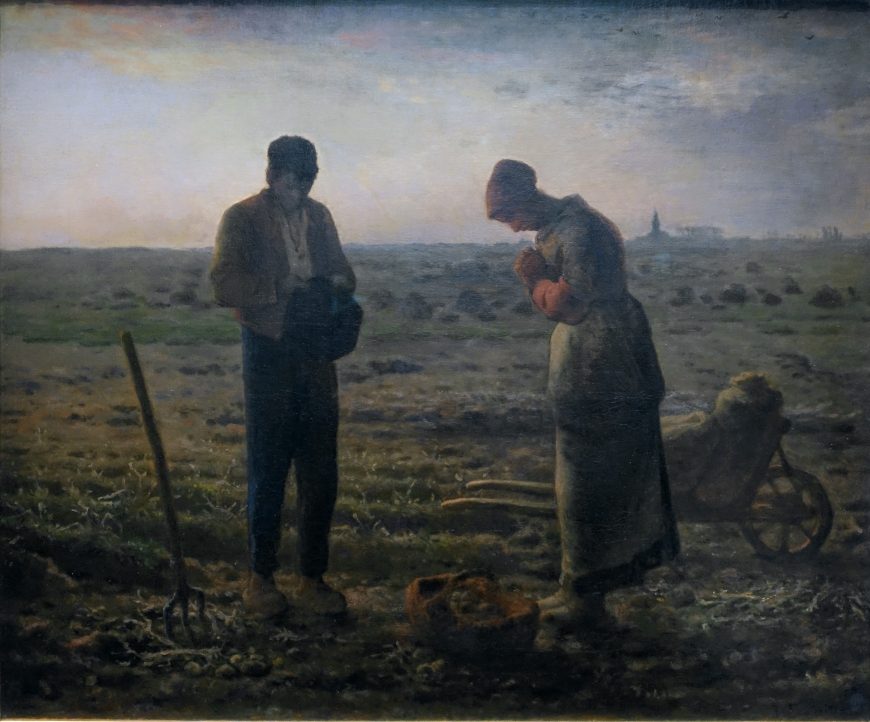
Jean-François Millet, L’Angélus, c. 1857-1859, oil on canvas, 21 x 26 (53.3 × 66.0 cm) (Musée d’Orsay, Paris)
However, for the Impressionists, unlike the Realists, contemporary subjects typically did not mean rural or provincial scenes, which often suggested timeless forms of life and labor (as in Millet’s L’Angélus), but rather urban and suburban subjects that were changing rapidly. In this they are among the first artists to examine an important change in human geography that had significantly transformed the human experience: the shift of populations from primarily rural to urban areas that accompanied the Industrial Revolution and its large-scale economic shift from agricultural to industrial production.
In 1863, the poet and art critic Charles Baudelaire wrote an influential essay titled “The Painter of Modern Life” that called for an artist who would stroll through the new spaces of the city, keenly observing the actions of its inhabitants and viewing the streets and crowds as though they constituted a sort of improvised theater put on for his observation. Monet’s Boulevard des Capucines presents a characteristically modern scene of the broad, tree-lined boulevards that were cut across the older, less regular streets and alleys of Paris, offering a sweeping perspective that was not previously available in the city.
Although they did not insist upon technological subjects as much as later modern art movements such as Italian Futurism or American Precisionism did, the Impressionists had a recognizable predilection for painting the spaces of Paris as it had been transformed within the past few decades. Along with the more stereotypical plein-air garden and landscape subjects, the Impressionists also frequently turned to scenes of contemporary urban experience. They painted Parisian cafés and beer halls; they painted the large theaters, opera houses, and cabarets of the city’s night-life, illuminated by the eerie green glow of the new gas lighting; they painted the bridges and grand boulevards of modern urban planning; they painted the new train stations, glass-and-iron cathedrals to modern technology and its promise of rapid movement of goods and ease of travel; and they painted the suburban restaurants, racetracks, beach resorts, and parks where the rising middle classes spent their leisure hours. These subjects may appear charmingly quaint to our eyes, but at the time they were as aggressively contemporary as paintings of skyscrapers, airports, highway rest areas, and office parks would be today.
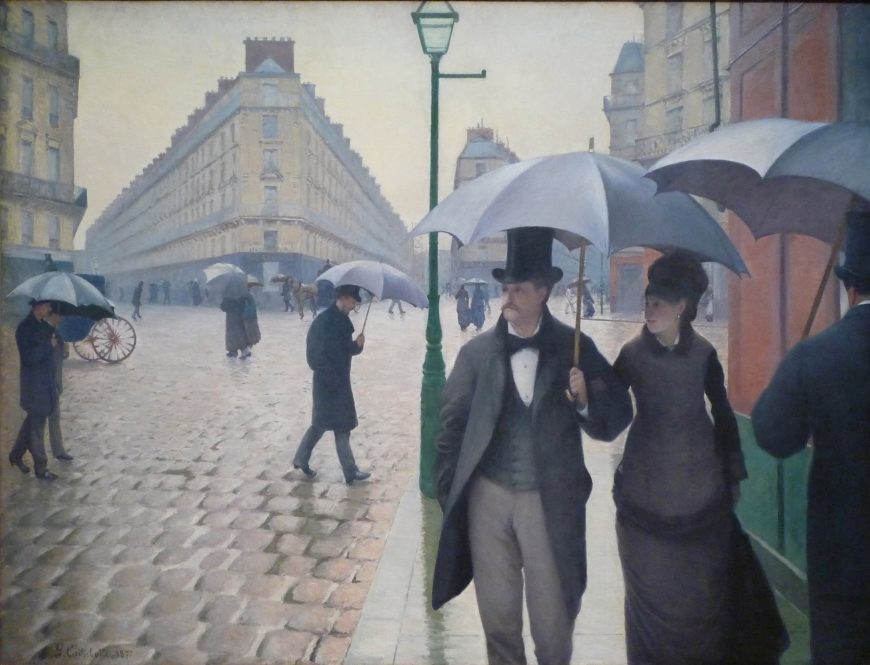
Gustave Caillebotte, Paris Street; Rainy Day, 1877, oil on canvas, 212.2 x 276.2 cm (The Art Institute of Chicago)
Middle-class leisure
Also unlike the Realists, the Impressionists tended to paint middle class leisure rather than lower class labor. This is a somewhat surprising limitation. Living alongside affluent urban professionals and moving through the same streets were thousands of poor manual laborers. But when we examine a panoramic street scene such as Gustave Caillebotte’s Paris Street; Rainy Day—another view of a modern boulevard—it is surprising to note there is only one person on the street whose dress marks him as lower class and whose occupation signals active labor: a distant man carrying a ladder, easily overlooked just to the right of the foreground man’s head. The exceptions to this general rule that the Impressionists painted bourgeois leisure rather than lower-class labor actually help to prove the rule. Impressionist paintings that show lower-class labor tend to depict the support industries of middle-class leisure: café waiters, beer-hall waitresses, cabaret singers, ballet dancers, laundresses, milliners, and prostitutes (and not the labor necessary to maintain the infrastructure of the city and the basic needs of its inhabitants). Even the paintings of lower class labor are fundamentally about middle class leisure.
Additional resources:
T.J. Clark, The Painting of Modern Life: Paris in the Art of Manet and his Followers (Princeton University Press, 1999).
Robert Herbert, Impressionism: Art, Leisure, and Parisian Society (Yale University Press, 1991).

